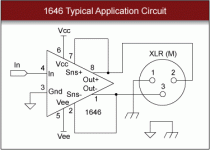Yeah, wouldn't it be nice if some vendor offered boards...😀
I'm working on it.
Sheeeshhh, I already have one wife!
Yeah, but SY looks pretty hot, and she doesn't nag (that it's already late and you should come to bed) while you're still enjoying yourself.
(mm, boards ?)
(mm, boards ?)
(mm, boards ?)
Yes, mmm.
My HMN is on some boards I had burned -- I will be sending out new Impasse boards in the next couple of weeks as well.
low ball balanced input approximation
In the sow's ear into silk purse department, I just achieved amazing hum reduction on my op amp disco mixer by 1. Drilling clearance holes in the steel case for the RCA jacks on the mag phono inputs (13/32") 2 Putting o-rings around the rca jacks so they don't touch the mixer case. The turntable headshell & arm is grounded through a separate wire to mixer case. 3. Grounding the mixer case to the power strip.(it has a 2 pin non-polarized plug) The grounds-returns are still tangled up on the mixer PCB with the power supply returns. The phono input is across 39k to Power supply ground on the + op amp input only. 4. regulating the op amp power supply with 8.2V zener diodes. I've got the hum low enough that I can hear the fan buried in the case of the CS800S power amp.
In the sow's ear into silk purse department, I just achieved amazing hum reduction on my op amp disco mixer by 1. Drilling clearance holes in the steel case for the RCA jacks on the mag phono inputs (13/32") 2 Putting o-rings around the rca jacks so they don't touch the mixer case. The turntable headshell & arm is grounded through a separate wire to mixer case. 3. Grounding the mixer case to the power strip.(it has a 2 pin non-polarized plug) The grounds-returns are still tangled up on the mixer PCB with the power supply returns. The phono input is across 39k to Power supply ground on the + op amp input only. 4. regulating the op amp power supply with 8.2V zener diodes. I've got the hum low enough that I can hear the fan buried in the case of the CS800S power amp.
Earthing and grounding is an art form i think. Ones you get the system clean, incredible things can happen.
jackinni
Sorry mate it is balanced
My mistake, I had SSM2019 on the brain.
Hi Joachim.
I got my copy of linear audio today
Brilliant definitely count me in for the next one.
I had a quick look at the Phono stage article and was wondering if you have tried the
LT1028.
(Please don’t misunderstand me in now way I am saying that I know best, I know very little in fact and I am just curious)
I tried those on a similar implementation as the INA "3 op amp inst amplifier they like much smaller resistors and to run hot.
I was wondering how you rate them for sonic performance
Are they better than AD797?
tanks
Al
I got my copy of linear audio today
Brilliant definitely count me in for the next one.
I had a quick look at the Phono stage article and was wondering if you have tried the
LT1028.
(Please don’t misunderstand me in now way I am saying that I know best, I know very little in fact and I am just curious)
I tried those on a similar implementation as the INA "3 op amp inst amplifier they like much smaller resistors and to run hot.
I was wondering how you rate them for sonic performance
Are they better than AD797?
tanks
Al
This is a late reply but assigning a particular sound to a particular Opamp is nonsense.
It is very important how you use it. I choose the NE5534A because it is not too fast and has also comparative low current noise. The LT1028 or AD797 would oszillate without modification to the lead-lag compensation. In fact i tried the AD797 and it got very hot.
That does not mean that it can not be adopted but why ? The NE5534A in the multiple shunt push-push configuration PLUS the gain in the input stage gives such a low distortion and noise that you can calibrate an Audio Precision with it.
It is very important how you use it. I choose the NE5534A because it is not too fast and has also comparative low current noise. The LT1028 or AD797 would oszillate without modification to the lead-lag compensation. In fact i tried the AD797 and it got very hot.
That does not mean that it can not be adopted but why ? The NE5534A in the multiple shunt push-push configuration PLUS the gain in the input stage gives such a low distortion and noise that you can calibrate an Audio Precision with it.
- Status
- Not open for further replies.
- Home
- Source & Line
- Analogue Source
- Phono MC/MM who is running balanced?
